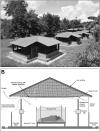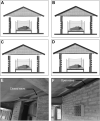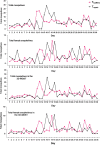Efficacy of 3D screens for sustainable mosquito control: a semi-field experimental hut evaluation in northeastern Tanzania
- PMID: 37964334
- PMCID: PMC10647037
- DOI: 10.1186/s13071-023-06032-4
Efficacy of 3D screens for sustainable mosquito control: a semi-field experimental hut evaluation in northeastern Tanzania
Abstract
Background: A three-dimensional window screen (3D-Screen) has been developed to create a window double-screen trap (3D-WDST), effectively capturing and preventing the escape of mosquitoes. A 2015 laboratory study demonstrated the 3D-Screen's efficacy, capturing 92% of mosquitoes in a double-screen setup during wind tunnel assays. To further evaluate its effectiveness, phase II experimental hut trials were conducted in Muheza, Tanzania.
Methods: Three experimental hut trials were carried out between 2016 and 2017. Trial I tested two versions of the 3D-WDST in huts with open or closed eaves, with one version using a single 3D-Screen and the other using two 3D-Screens. Trial II examined the 3D-WDST with two 3D-Screens in huts with or without baffles, while Trial III compared handmade and machine-made 3D structures. Mosquito capturing efficacy of the 3D-WDST was measured by comparing the number of mosquitoes collected in the test hut to a control hut with standard exit traps.
Results: Trial I showed that the 3D-WDST with two 3D-Screens used in huts with open eaves achieved the highest mosquito-capturing efficacy. This treatment captured 33.11% (CI 7.40-58.81) of female anophelines relative to the total collected in this hut (3D-WDST and room collections) and 27.27% (CI 4.23-50.31) of female anophelines relative to the total collected in the control hut (exit traps, room, and verandahs collections). In Trial II, the two 3D-Screens version of the 3D-WDST captured 70.32% (CI 56.87-83.77) and 51.07% (CI 21.72-80.41) of female anophelines in huts with and without baffles, respectively. Compared to the control hut, the capturing efficacy for female anophelines was 138.6% (37.23-239.9) and 42.41% (14.77-70.05) for huts with and without baffles, respectively. Trial III demonstrated similar performance between hand- and machine-made 3D structures.
Conclusions: The 3D-WDST proved effective in capturing malaria vectors under semi-field experimental hut conditions. Using 3D-Screens on both sides of the window openings was more effective than using a single-sided 3D-Screen. Additionally, both hand- and machine-made 3D structures exhibited equally effective performance, supporting the production of durable cones on an industrial scale for future large-scale studies evaluating the 3D-WDST at the community level.
Keywords: 3D-Screens; 3D-WDST; Anopheles; Experimental huts; Malaria; Mosquito control; Muheza; Northeastern Tanzania; Window double screens.
© 2023. The Author(s).
Conflict of interest statement
The authors declare no competing interests.
Figures














References
-
- Walter K, John CC. Malaria Jama. 2022;327:597–597. - PubMed
-
- World Health Organization. World malaria report 2021. 2021.
MeSH terms
Substances
LinkOut - more resources
Full Text Sources
Medical

